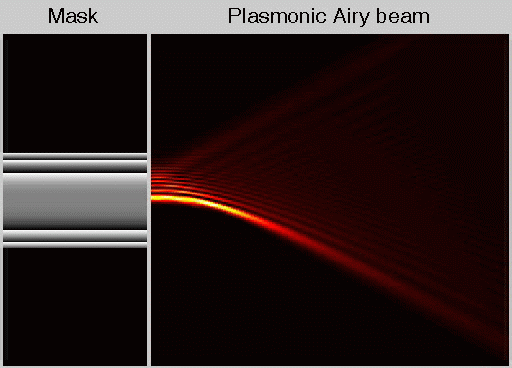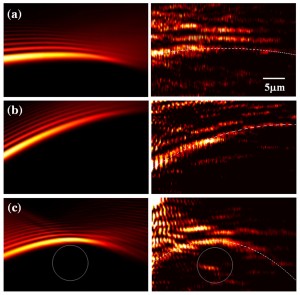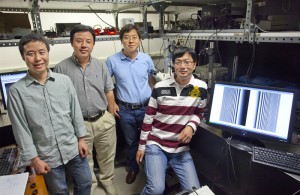
The movie shows the computer-based dynamical control of the trajectory and peak intensity position of plasmonic Airy beams achieved by Berkeley Lab’s Xiang Zhang.
Now, scientists with the Lawrence Berkeley National Laboratory (Berkeley Lab) have demonstrated the first technique that provides dynamic control in real-time of the curved trajectories of Airy beams over metallic surfaces. This development paves the way for fast-as-light, ultra-compact communication systems and optoelectronic devices,and could also stimulate revolutions in chemistry, biology and medicine.
The key to the success of this work was their ability to directly couple free-space Airy beams – using a standard tool of optics called a “grating coupler” – to quasi-particles called surface plasmon polaritons (SPPs). Directing a laser beam of light across the surface of a metal nanostructure generates electronic surface waves – called plasmons – that roll through the metal’s conduction electrons (those loosely attached to molecules and atoms). The resulting interaction between plasmons and photons creates SPPs. By directly coupling Airy beams to SPPs, the researchers are able to manipulate light at an extremely small scale beyond the diffraction limit.
“Dynamic controllability of SPPs is extremely desirable for reconfigurable optical interconnections,” says Xiang Zhang, the leader of this research. “We have provided a novel approach of plasmonic Airy beam to manipulate SPPs without the need of any waveguide structures over metallic surfaces, providing dynamic control of their ballistic trajectories despite any surface roughness and defects, or even getting around obstacles. This is promising not only for applications in reconfigurable optical interconnections but also for precisely manipulating particles on extremely small scales.”

Examples of the dynamic control of the plasmonic Airy beams shows switching the trajectories to different directions (a,b) and bypassing obstacles (gray solid circle in c). Left panels are numerical simulations, right panels are experimental demonstrations (courtesy of Zhang group)
Zhang, a principal investigator with Berkeley Lab’s Materials Sciences Division and director of the University of California at Berkeley’s Nano-scale Science and Engineering Center (SINAM), is the corresponding author of a paper published in the journal Optics Letters. The paper is titled “Plasmonic Airy beams with dynamically controlled trajectories.” Coauthoring the paper were Peng Zhang, Sheng Wang, Yongmin Liu, Xiaobo Yin, Changgui Lu and Zhigang Chen.
“Up to now, different plasmonic elements for manipulating surface plasmons were realized either through structuring metal surfaces or by placing dielectric structures on metals,” says Peng Zhang, lead author of the Optics Letters paper and member of Xiang Zhang’s research group. “Both approaches are based on the fabrication of permanent nanostructures on the metal surface, which are very difficult if not impossible to reconfigure in real time. Reconfigurability is crucial to optical interconnections, which in turn are crucial for high performance optical computing and communication systems. The reconfigurability of our technique is a huge advantage over previous approaches.”
Adds co-author Zhigang Chen, a principal investigator with the Department of Physics and Astronomy at San Francisco State University, “With the reconfigurability of our plasmonic Airy beams, a small number of optical devices can be employed to perform a large number of functions within a compact system. In addition, the unique properties of the plasmonic Airy beams open new opportunities for on-chip energy routing along arbitrary trajectories in plasmonic circuitry, and allows for dynamic manipulations of nano-particles on metal surfaces and in magneto-electronic devices.”
Dynamic control of the plasmonic Airy beams is provided by a computer-controlled spatial light modulator, a device similar to a liquid crystal display that can be used to offset the incoming light waves from a laser beam with respect to a cubic phase system mask and a Fourier lens. This generates a plasmonic Airy beam on the surface of a metal whose ballistic motion can be modified.

From left Yongmin Liu, Xiang Zhang, Peng Zhang, and Sheng Wang were part of a team that developed the first technique for dynamically controlling plasmonic Airy beams without the need of waveguides and other permanent structures. (Photo by Roy Kaltschmidt)
The ability of the spatial light modulator to dynamically control the ballistic motions of plasmonic Airy beams without the need of any permanent guiding structures should open doors to a number of new technologies, according to Xiang and Peng Zhang and their collaborators. For example, in nano-photonics, it enables researchers to design practical reconfigurable plasmonic sensors or perform nano-particle tweezing on microchips. In biology and chemistry, it allows researchers to dynamically manipulate molecules.
Says Sheng Wang, second lead author of the Optics Letters paper, “The ultrafine nature of SPPs is extremely promising for applications of nanolithography or nanoimaging. Having dynamic tunable plasmonic Airy beams should also be useful for ultrahigh resolution bioimaging. For example, we can directly illuminate a target, for example a protein, bypassing any obstacles or reducing the background.”
Adds third lead author Yongmin Liu, “Our findings may inspire researchers to explore other types of non-diffracting surface waves, such as electron spin waves, in other two-dimensional systems, including graphene and topological insulators.”
This work was supported by the U.S. Army Research Office, the U.S. Air Force Office of Scientific Research, and the National Science Foundation Nanoscale Science and Engineering Center.
###
Lawrence Berkeley National Laboratory addresses the world’s most urgent scientific challenges by advancing sustainable energy, protecting human health, creating new materials, and revealing the origin and fate of the universe. Founded in 1931, Berkeley Lab’s scientific expertise has been recognized with 12 Nobel prizes. The University of California manages Berkeley Lab for the U.S. Department of Energy’s Office of Science. For more, visit www.lbl.gov.
Additional Information
For more information about the research of Xiang Zhang visit http://xlab.me.berkeley.edu/